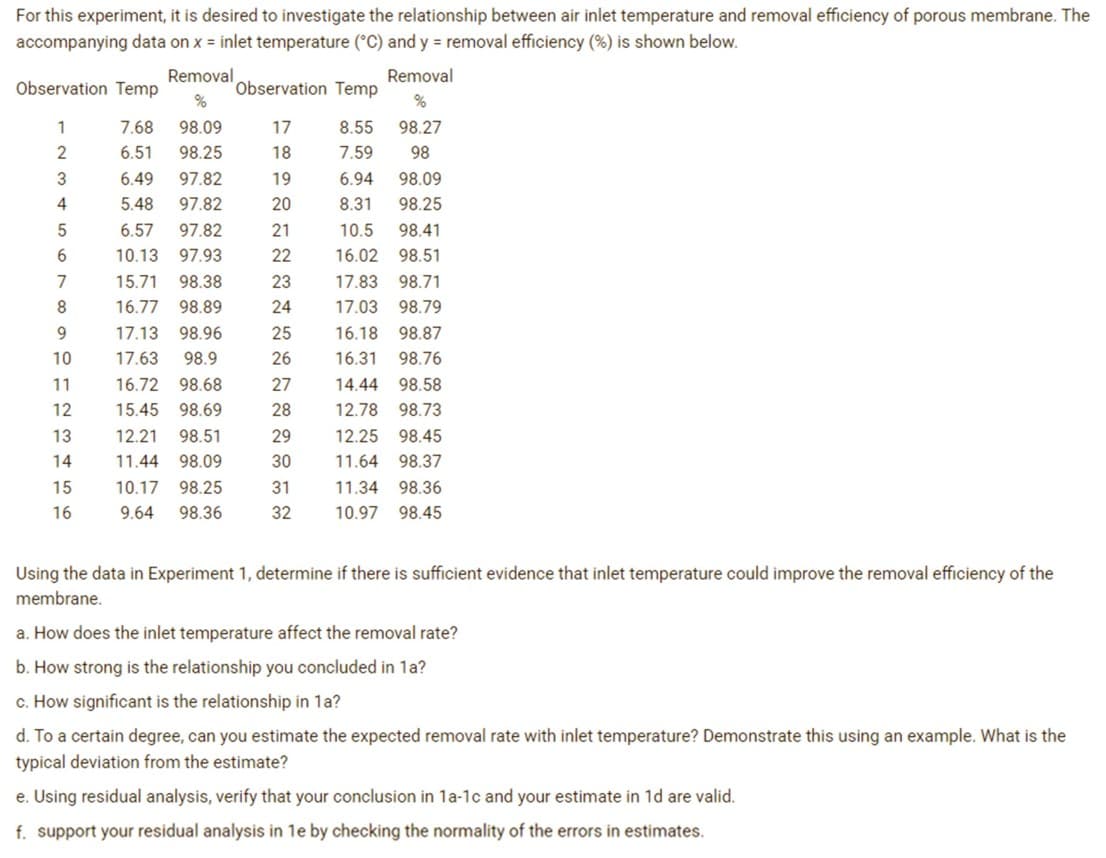For this experiment, it is desired to investigate the relationship between air inlet temperature and removal efficiency of porous membrane. The accompanying data on x = inlet temperature (°C) and y = removal efficiency (%) is shown below. Removal Removal Observation Temp Observation Temp 1 7.68 98.09 17 8.55 98.27 2 6.51 98.25 18 7.59 98 6.49 97.82 19 6.94 98.09 4 5.48 97.82 20 8.31 98.25 6.57 97.82 21 10.5 98.41 6. 10.13 97.93 22 16.02 98.51 7 15.71 98.38 23 17.83 98.71 8. 16.77 98.89 24 17.03 98.79 9. 17.13 98.96 25 16.18 98.87 10 17.63 98.9 26 16.31 98.76 11 16.72 98.68 27 14.44 98.58 12 15.45 98.69 28 12.78 98.73 13 12.21 98.51 29 12.25 98.45 14 11.44 98.09 30 11.64 98.37 15 10.17 98.25 31 11.34 98.36 16 9.64 98.36 32 10.97 98.45 Using the data in Experiment 1, determine if there is sufficient evidence that inlet temperature could improve the removal efficiency of the membrane. a. How does the inlet temperature affect the removal rate? b. How strong is the relationship you concluded in 1a? c. How significant is the relationship in 1a? d. To a certain degree, can you estimate the expected removal rate with inlet temperature? Demonstrate this using an example. What is the typical deviation from the estimate? e. Using residual analysis, verify that your conclusion in 1a-1c and your estimate in 1d are valid. f. support your residual analysis in 1e by checking the normality of the errors in estimates.
For this experiment, it is desired to investigate the relationship between air inlet temperature and removal efficiency of porous membrane. The accompanying data on x = inlet temperature (°C) and y = removal efficiency (%) is shown below. Removal Removal Observation Temp Observation Temp 1 7.68 98.09 17 8.55 98.27 2 6.51 98.25 18 7.59 98 6.49 97.82 19 6.94 98.09 4 5.48 97.82 20 8.31 98.25 6.57 97.82 21 10.5 98.41 6. 10.13 97.93 22 16.02 98.51 7 15.71 98.38 23 17.83 98.71 8. 16.77 98.89 24 17.03 98.79 9. 17.13 98.96 25 16.18 98.87 10 17.63 98.9 26 16.31 98.76 11 16.72 98.68 27 14.44 98.58 12 15.45 98.69 28 12.78 98.73 13 12.21 98.51 29 12.25 98.45 14 11.44 98.09 30 11.64 98.37 15 10.17 98.25 31 11.34 98.36 16 9.64 98.36 32 10.97 98.45 Using the data in Experiment 1, determine if there is sufficient evidence that inlet temperature could improve the removal efficiency of the membrane. a. How does the inlet temperature affect the removal rate? b. How strong is the relationship you concluded in 1a? c. How significant is the relationship in 1a? d. To a certain degree, can you estimate the expected removal rate with inlet temperature? Demonstrate this using an example. What is the typical deviation from the estimate? e. Using residual analysis, verify that your conclusion in 1a-1c and your estimate in 1d are valid. f. support your residual analysis in 1e by checking the normality of the errors in estimates.
MATLAB: An Introduction with Applications
6th Edition
ISBN:9781119256830
Author:Amos Gilat
Publisher:Amos Gilat
Chapter1: Starting With Matlab
Section: Chapter Questions
Problem 1P
Related questions
Question
Please help me answer letters d to f.

Transcribed Image Text:For this experiment, it is desired to investigate the relationship between air inlet temperature and removal efficiency of porous membrane. The
accompanying data on x = inlet temperature (°C) and y = removal efficiency (%) is shown below.
Removal
Removal
Observation Temp
Observation Temp
1
7.68
98.09
17
8.55
98.27
2
6.51
98.25
18
7.59
98
3
6.49
97.82
19
6.94
98.09
5.48
97.82
20
8.31
98.25
6.57
97.82
21
10.5
98.41
10.13
97.93
22
16.02 98.51
7
15.71
98.38
23
17.83
98.71
8.
16.77
98.89
24
17.03 98.79
9.
17.13
98.96
25
16.18
98.87
10
17.63
98.9
26
16.31
98.76
11
16.72 98.68
27
14.44 98.58
12
15.45
98.69
28
12.78
98.73
13
12.21
98.51
29
12.25 98.45
14
11.44
98.09
30
11.64
98.37
15
10.17
98.25
31
11.34
98.36
16
9.64
98.36
32
10.97
98.45
Using the data in Experiment 1, determine if there is sufficient evidence that inlet temperature could improve the removal efficiency of the
membrane.
a. How does the inlet temperature affect the removal rate?
b. How strong is the relationship you concluded in 1a?
c. How significant is the relationship in 1a?
d. To a certain degree, can you estimate the expected removal rate with inlet temperature? Demonstrate this using an example. What is the
typical deviation from the estimate?
e. Using residual analysis, verify that your conclusion in 1a-1c and your estimate in 1d are valid.
f. support your residual analysis in 1e by checking the normality of the errors in estimates.
Expert Solution
This question has been solved!
Explore an expertly crafted, step-by-step solution for a thorough understanding of key concepts.
Step by step
Solved in 4 steps

Recommended textbooks for you

MATLAB: An Introduction with Applications
Statistics
ISBN:
9781119256830
Author:
Amos Gilat
Publisher:
John Wiley & Sons Inc

Probability and Statistics for Engineering and th…
Statistics
ISBN:
9781305251809
Author:
Jay L. Devore
Publisher:
Cengage Learning

Statistics for The Behavioral Sciences (MindTap C…
Statistics
ISBN:
9781305504912
Author:
Frederick J Gravetter, Larry B. Wallnau
Publisher:
Cengage Learning

MATLAB: An Introduction with Applications
Statistics
ISBN:
9781119256830
Author:
Amos Gilat
Publisher:
John Wiley & Sons Inc

Probability and Statistics for Engineering and th…
Statistics
ISBN:
9781305251809
Author:
Jay L. Devore
Publisher:
Cengage Learning

Statistics for The Behavioral Sciences (MindTap C…
Statistics
ISBN:
9781305504912
Author:
Frederick J Gravetter, Larry B. Wallnau
Publisher:
Cengage Learning

Elementary Statistics: Picturing the World (7th E…
Statistics
ISBN:
9780134683416
Author:
Ron Larson, Betsy Farber
Publisher:
PEARSON

The Basic Practice of Statistics
Statistics
ISBN:
9781319042578
Author:
David S. Moore, William I. Notz, Michael A. Fligner
Publisher:
W. H. Freeman

Introduction to the Practice of Statistics
Statistics
ISBN:
9781319013387
Author:
David S. Moore, George P. McCabe, Bruce A. Craig
Publisher:
W. H. Freeman